Solar eclipse of February 26, 2017
An annular solar eclipse took place on February 26, 2017.[1][2][3] A solar eclipse occurs when the Moon passes between Earth and the Sun, thereby totally or partly obscuring the image of the Sun for a viewer on Earth. An annular solar eclipse occurs when the Moon's apparent diameter is smaller than the Sun's, blocking most of the Sun's light and causing the Sun to look like an annulus (ring). An annular eclipse appears as a partial eclipse over a region of the Earth thousands of kilometres wide. Occurring only 4.7 days before perigee (Perigee on March 3, 2017), the Moon's apparent diameter was larger. The moon's apparent diameter was just over 0.7% smaller than the Sun's.
It was visible across southern South America in the morning and ended in south-western Africa at sunset. In Argentina, the best places to see the eclipse were located in the south of the Chubut Province, in the towns of Facundo, Sarmiento and Camarones. Lunar perigee occurred at about 2017 Mar 03 at 07:41:24.5 UTC, 4.7 days later.
Predictions and additional information
Eclipse characteristics
Eclipse magnitude: 0.99223
Eclipse obscuration: 0.98451
Gamma: -0.45780
Saros Series: 140th (29 of 71)
Conjunction times
Greatest eclipse: 26 Feb 2017 14:53:24.5 UTC (14:54:32.8 TD)
Ecliptic conjunction: 26 Feb 2017 14:58:23.4 UTC (14:59:31.7 TD)
Equatorial Ccnjunction: 26 Feb 2017 14:38:46.0 UTC (14:39:54.4 TD)
Geocentric coordinates of sun and moon
Sun right ascension: 22.656
Sun declination: -8.49°
Sun diameter: 1938.0 arcseconds
Moon right ascension: 22.665
Moon declination: -8.92°
Moon diameter: 1895.6 arcseconds
Geocentric libration of moon
Latitude: 5.1 degrees south
Longitude: 0.6 degrees east
Direction: 336.5 (NNW)
Images

Gallery
-
 Partial from Villa Gesell, Argentina, 13:18 GMT
Partial from Villa Gesell, Argentina, 13:18 GMT -
 Coyhaique, Chile, 13:35 GMT, 1 minute before annularity
Coyhaique, Chile, 13:35 GMT, 1 minute before annularity -
 Partial from Pisco Elqui, Chile, 13:48 GMT
Partial from Pisco Elqui, Chile, 13:48 GMT -
 Partial from Punta del Este, Uruguay, 13:56 GMT
Partial from Punta del Este, Uruguay, 13:56 GMT -
 Partial from Puerto Cisnes, Chile, 14:17 GMT
Partial from Puerto Cisnes, Chile, 14:17 GMT -
 Composed image as seen from Paraná, Argentina
Composed image as seen from Paraná, Argentina -
 Time lapse images as seen from Villa Gesell, Argentina
Time lapse images as seen from Villa Gesell, Argentina -
 Animation of the eclipse as seen from Montevideo, Uruguay
Animation of the eclipse as seen from Montevideo, Uruguay
Related eclipses
Eclipses of 2017
- A penumbral lunar eclipse on February 11.
- An annular solar eclipse on February 26.
- A partial lunar eclipse on August 7.
- A total solar eclipse on August 21.
Solar eclipses descending node 2015-2018
- Saros 120: Total Solar Eclipse March 20, 2015
- Saros 130: Total Solar Eclipse March 8–9, 2016
- Saros 140: Annular Solar Eclipse February 26, 2017
- Saros 150: Partial Solar Eclipse February 15, 2018
Tzolkinex
Preceded: Solar eclipse of January 15, 2010
Followed: Solar eclipse of April 8, 2024
Half-Saros cycle
Preceded: Lunar eclipse of February 21, 2008
Followed: Lunar eclipse of March 3, 2026
Tritos
Preceded: Solar eclipse of March 29, 2006
Followed: Solar eclipse of January 26, 2028
Solar Saros 140
Preceded: Solar eclipse of February 16, 1999
Followed: Solar eclipse of March 9, 2035
Inex
Preceded: Solar eclipse of March 18, 1988
Followed: Solar eclipse of February 5, 2046
Triad
Preceded: Solar eclipse of April 28, 1930
Followed: Solar eclipse of December 29, 2103
Solar eclipses 2015–2018
This eclipse is a member of a semester series. An eclipse in a semester series of solar eclipses repeats approximately every 177 days and 4 hours (a semester) at alternating nodes of the Moon's orbit.[4]
| Descending node | Ascending node | |||||
|---|---|---|---|---|---|---|
| Saros | Map | Gamma | Saros | Map | Gamma | |
120 Longyearbyen, Svalbard | 2015 March 20 Total | 0.94536 | 125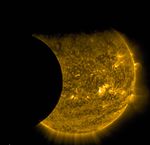 Solar Dynamics Observatory | 2015 September 13  Partial (south) | −1.10039 | |
130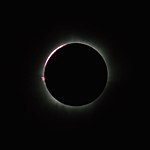 Balikpapan, Indonesia | 2016 March 9 Total | 0.26092 | 135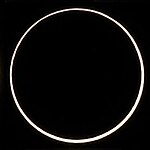 L'Étang-Salé, Réunion | 2016 September 1 Annular | −0.33301 | |
140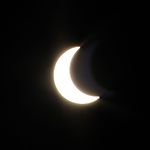 Partial from Buenos Aires | 2017 February 26 Annular | −0.45780 | 145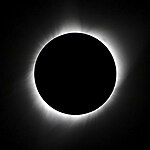 Casper, Wyoming | 2017 August 21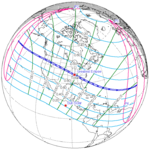 Total | 0.43671 | |
150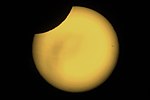 Partial from Olivos, Buenos Aires | 2018 February 15 Partial (south) | −1.21163 | 155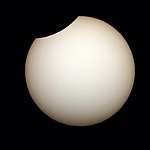 Partial from Huittinen, Finland | 2018 August 11 Partial (north) | 1.14758 | |
Partial solar eclipses on July 13, 2018, and January 6, 2019, occur during the next semester series.
Saros 140
It is a part of Saros cycle 140, repeating every 18 years, 11 days, containing 71 events. The series started with partial solar eclipse on April 16, 1512. It contains total eclipses from July 21, 1656 through November 9, 1836, hybrid eclipses from November 20, 1854 through December 23, 1908, and annular eclipses from January 3, 1927 through December 7, 2485. The series ends at member 71 as a partial eclipse on June 1, 2774. The longest duration of totality was 4 minutes, 10 seconds on August 12, 1692.
| Series members 23–53 occur between 1901 and 2450: | ||
|---|---|---|
| 23 | 24 | 25 |
 Dec 23, 1908 |  Jan 3, 1927 |  Jan 14, 1945 |
| 26 | 27 | 28 |
 Jan 25, 1963 |  Feb 4, 1981 |  Feb 16, 1999 |
| 29 | 30 | 31 |
 Feb 26, 2017 |  Mar 9, 2035 |  Mar 20, 2053 |
| 32 | 33 | 34 |
 Mar 31, 2071 |  Apr 10, 2089 |  Apr 23, 2107 |
| 35 | 36 | 37 |
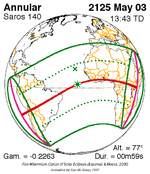 May 3, 2125 | 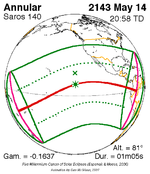 May 14, 2143 | 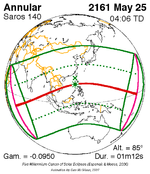 May 25, 2161 |
| 38 | 39 | 40 |
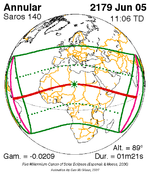 Jun 5, 2179 |  Jun 15, 2197 |  Jun 28, 2215 |
| 41 | 42 | 43 |
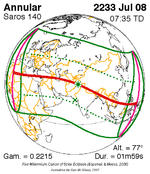 Jul 8, 2233 | 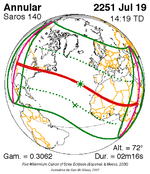 Jul 19, 2251 | 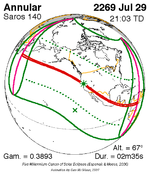 Jul 29, 2269 |
| 44 | 45 | 46 |
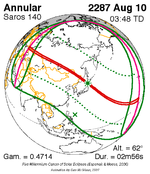 Aug 10, 2287 | 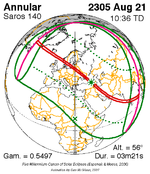 Aug 21, 2305 |  Sep 1, 2323 |
| 47 | 48 | 49 |
 Sep 12, 2341 | 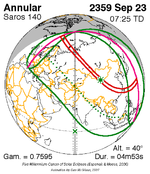 Sep 23, 2359 |  Oct 3, 2377 |
| 50 | 51 | 52 |
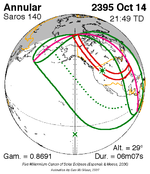 Oct 14, 2395 | 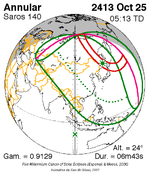 Oct 25, 2413 |  Nov 5, 2431 |
| 53 | ||
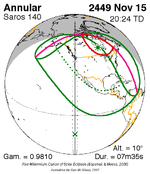 Nov 15, 2449 | ||
Inex series
This eclipse is a part of the long period inex cycle, repeating at alternating nodes, every 358 synodic months (≈ 10,571.95 days, or 29 years minus 20 days). Their appearance and longitude are irregular due to a lack of synchronization with the anomalistic month (period of perigee). However, groupings of 3 inex cycles (≈ 87 years minus 2 months) comes close (≈ 1,151.02 anomalistic months), so eclipses are similar in these groupings.
| Inex series members between 1901 and 2100: | ||
|---|---|---|
 May 18, 1901 (Saros 136) |  April 28, 1930 (Saros 137) |  April 8, 1959 (Saros 138) |
 March 18, 1988 (Saros 139) |  February 26, 2017 (Saros 140) |  February 5, 2046 (Saros 141) |
 January 16, 2075 (Saros 142) | ||
Metonic cycle
The metonic series repeats eclipses every 19 years (6939.69 days), lasting about 5 cycles. Eclipses occur in nearly the same calendar date. In addition, the octon subseries repeats 1/5 of that or every 3.8 years (1387.94 days). All eclipses in this table occur at the Moon's descending node.
| 21 events between July 22, 1971 and July 22, 2047 | ||||
|---|---|---|---|---|
| July 21–22 | May 9–11 | February 26–27 | December 14–15 | October 2–3 |
| 116 | 118 | 120 | 122 | 124 |
 July 22, 1971 |  May 11, 1975 |  February 26, 1979 |  December 15, 1982 |  October 3, 1986 |
| 126 | 128 | 130 | 132 | 134 |
 July 22, 1990 |  May 10, 1994 |  February 26, 1998 |  December 14, 2001 |  October 3, 2005 |
| 136 | 138 | 140 | 142 | 144 |
 July 22, 2009 |  May 10, 2013 |  February 26, 2017 |  December 14, 2020 |  October 2, 2024 |
| 146 | 148 | 150 | 152 | 154 |
 July 22, 2028 |  May 9, 2032 |  February 27, 2036 |  December 15, 2039 |  October 3, 2043 |
| 156 | ||||
 July 22, 2047 | ||||
Notes and references
- ^ Cofield, Calla (February 26, 2017). "Moon Blocks (Most of) the Sun in 'Ring of Fire' Solar Eclipse". Space.com.
- ^ Dwyer, Colin (February 25, 2017). "'Ring Of Fire' Eclipse Set To Blaze In Southern Skies". NPR.
- ^ ""Ring of fire" annular eclipse: Stunning views of first solar eclipse of 2017". www.cbsnews.com. February 27, 2017.
- ^ van Gent, R.H. "Solar- and Lunar-Eclipse Predictions from Antiquity to the Present". A Catalogue of Eclipse Cycles. Utrecht University. Retrieved 6 October 2018.
References
- www.solar-eclipse.de - The annular solar eclipse of 02/26/2017
- NASA graphics
- Interactive map of the eclipse from NASA
- NASA Besselian Elements - Annular Solar Eclipse of 2017 February 26
- hermet.org: Annular Solar Eclipse: February 26 2017
External links

- www.solar-eclipse.de - Average cloud coverage and cities along the eclipse path
- v
- t
- e
| By era | |
|---|---|
| Saros series | |
| Visibility | |
| Historical |
|

Total/hybrid eclipses
→ next total/hybrid
- 1560
- 1598
- 1652
- 1654
- 1673
- 1699
- 1706
- 1715
- 1724
- 1766
- 1778
- 1780
- 1806
- 1816
- 1824
- 1842
- 1851
- 1853
- 1857
- 1858
- 1860
- 1865
- 1867
- 1868
- 1869
- 1870
- 1871
- 1874
- 1875
- 1878
- 1882
- 1883
- 1885
- 1886
- 1887
- Jan 1889
- Dec 1889
- 1893
- 1896
- 1898
- 1900
- 1901
- 1903
- 1904
- 1905
- 1907
- Jan 1908
- Dec 1908
- 1909
- 1910
- 1911
- Apr 1912
- Oct 1912
- 1914
- 1916
- 1918
- 1919
- 1921
- 1922
- 1923
- 1925
- 1926
- 1927
- 1928
- 1929
- Apr 1930
- Oct 1930
- 1932
- 1934
- 1936
- 1937
- 1938
- 1939
- 1940
- 1941
- 1943
- Jan 1944
- 1945
- 1947
- 1948
- 1950
- 1952
- 1954
- 1955
- 1956
- 1957
- 1958
- 1959
- 1961
- 1962
- 1963
- 1965
- 1966
- 1967
- 1968
- 1970
- 1972
- 1973
- 1974
- 1976
- 1977
- 1979
- 1980
- 1981
- 1983
- 1984
- 1985
- 1986
- 1987
- 1988
- 1990
- 1991
- 1992
- 1994
- 1995
- 1997
- 1998
- 1999
- 2001
- 2002
- 2003
- 2005
- 2006
- 2008
- 2009
- 2010
- 2012
- 2013
- 2015
- 2016
- 2017
- 2019
- 2020
- 2021
- 2023
- → 2024
- 2026
- 2027
- 2028
- 2030
- 2031
- 2033
- 2034
- 2035
- 2037
- 2038
- 2039
- 2041
- 2042
- 2043
- 2044
- 2045
- 2046
- 2048
- 2049
- 2050
- 2052
- 2053
- 2055
- Jan 2057
- Dec 2057
- 2059
- 2060
- 2061
- 2063
- 2064
- 2066
- 2067
- 2068
- 2070
- 2071
- 2072
- 2073
- 2075
- 2076
- 2077
- 2078
- 2079
- 2081
- 2082
- 2084
- 2086
- 2088
- 2089
- 2090
- 2091
- 2093
- 2094
- 2095
- 2096
- 2097
- 2099
- 2100
- 2114
- 2117
- 2126
- 2132
- 2150
- 2153
- 2168
- 2178
- 2186

Annular eclipses
→ next annular
- 1820
- 1854
- 1879
- 1889
- 1900
- 1901
- 1903
- 1904
- 1905
- 1907
- 1908
- 1911
- 1914
- Feb 1915
- Aug 1915
- 1916
- 1917
- 1918
- 1919
- 1921
- 1922
- 1923
- 1925
- 1926
- 1927
- 1929
- 1932
- Feb 1933
- Aug 1933
- 1934
- 1935
- 1936
- 1937
- 1939
- 1940
- 1941
- 1943
- Jul 1944
- 1945
- 1947
- 1948
- 1950
- Mar 1951
- Sep 1951
- 1952
- Jan 1954
- Dec 1954
- 1955
- 1957
- 1958
- 1959
- 1961
- 1962
- 1963
- 1965
- 1966
- Mar 1969
- Sep 1969
- 1970
- 1972
- Jan 1973
- Dec 1973
- 1976
- 1977
- 1979
- 1980
- 1981
- 1983
- 1984
- 1987
- 1988
- 1990
- 1991
- 1992
- 1994
- 1995
- 1998
- 1999
- 2001
- 2002
- 2003
- 2005
- 2006
- 2008
- 2009
- 2010
- 2012
- 2013
- 2014
- 2016
- 2017
- 2019
- 2020
- 2021
- 2023
- → 2024
- 2026
- 2027
- 2028
- 2030
- 2031
- 2032
- 2034
- 2035
- 2036
- Jan 2038
- Jul 2038
- 2039
- 2041
- 2042
- 2043
- 2044
- 2045
- 2046
- 2048
- 2049
- 2052
- 2053
- Jan 2056
- Jul 2056
- 2057
- 2059
- 2060
- 2061
- 2063
- 2064
- 2066
- 2067
- 2070
- 2071
- Jan 2074
- Jul 2074
- 2075
- 2077
- 2078
- 2079
- 2081
- 2082
- 2084
- Jun 2085
- Dec 2085
- 2088
- 2089
- Feb 2092
- Aug 2092
- 2093
- 2095
- 2096
- 2097
- 2099
- 2100
- 2101
- Jan 2168
- Dec 2168
- Apr 2191
- 2200

Partial eclipses
→ next partial
- Jan 1639
- Apr 1902
- May 1902
- Oct 1902
- Feb 1906
- Jul 1906
- Aug 1906
- Dec 1909
- Nov 1910
- Apr 1913
- Aug 1913
- Sep 1913
- Dec 1916
- Jan 1917
- Jun 1917
- Jul 1917
- May 1920
- Nov 1920
- Mar 1924
- Jul 1924
- Aug 1924
- Dec 1927
- Jun 1928
- Nov 1928
- Apr 1931
- Sep 1931
- Oct 1931
- Jan 1935
- Feb 1935
- Jun 1935
- Jul 1935
- Nov 1938
- Mar 1942
- Aug 1942
- Sep 1942
- Jan 1946
- May 1946
- Jun 1946
- Nov 1946
- Apr 1949
- Oct 1949
- Feb 1953
- Jul 1953
- Aug 1953
- Dec 1956
- Mar 1960
- Sep 1960
- Jan 1964
- Jun 1964
- Jul 1964
- Dec 1964
- May 1967
- Mar 1968
- Feb 1971
- Jul 1971
- Aug 1971
- Dec 1974
- May 1975
- Nov 1975
- Apr 1978
- Oct 1978
- Jan 1982
- Jun 1982
- Jul 1982
- Dec 1982
- May 1985
- Apr 1986
- Mar 1989
- Aug 1989
- Dec 1992
- May 1993
- Nov 1993
- Apr 1996
- Oct 1996
- Sep 1997
- Feb 2000
- 1 Jul 2000
- 31 Jul 2000
- Dec 2000
- Apr 2004
- Oct 2004
- Mar 2007
- Sep 2007
- Jan 2011
- Jun 2011
- Jul 2011
- Nov 2011
- Oct 2014
- Sep 2015
- Feb 2018
- Jul 2018
- Aug 2018
- Jan 2019
- Apr 2022
- Oct 2022
- → Mar 2025
- Sep 2025
- Jan 2029
- Jun 2029
- Jul 2029
- Dec 2029
- 2032
- 2033
- Feb 2036
- Jul 2036
- Aug 2036
- 2037
- May 2040
- Nov 2040
- Jan 2047
- Jun 2047
- Jul 2047
- Dec 2047
- 2050
- Apr 2051
- Oct 2051
- Mar 2054
- Aug 2054
- Sep 2054
- 2055
- May 2058
- Jun 2058
- Nov 2058
- Mar 2062
- Sep 2062
- Feb 2065
- Jul 2065
- Aug 2065
- Dec 2065
- 2068
- Apr 2069
- May 2069
- Oct 2069
- 2072
- 2073
- Jun 2076
- Jul 2076
- Nov 2076
- Feb 2083
- Jul 2083
- Aug 2083
- 2084
- 2086
- May 2087
- Jun 2087
- Oct 2087
- 2090
- 2091
- Jun 2094
- Jul 2094
- Dec 2094
- Apr 2098
- Sep 2098
- Oct 2098
- Apr 2108
- Jul 2195
 Astronomy portal
Astronomy portal Solar System portal
Solar System portal Category
Category
 | This solar eclipse–related article is a stub. You can help Wikipedia by expanding it. |
- v
- t
- e




















